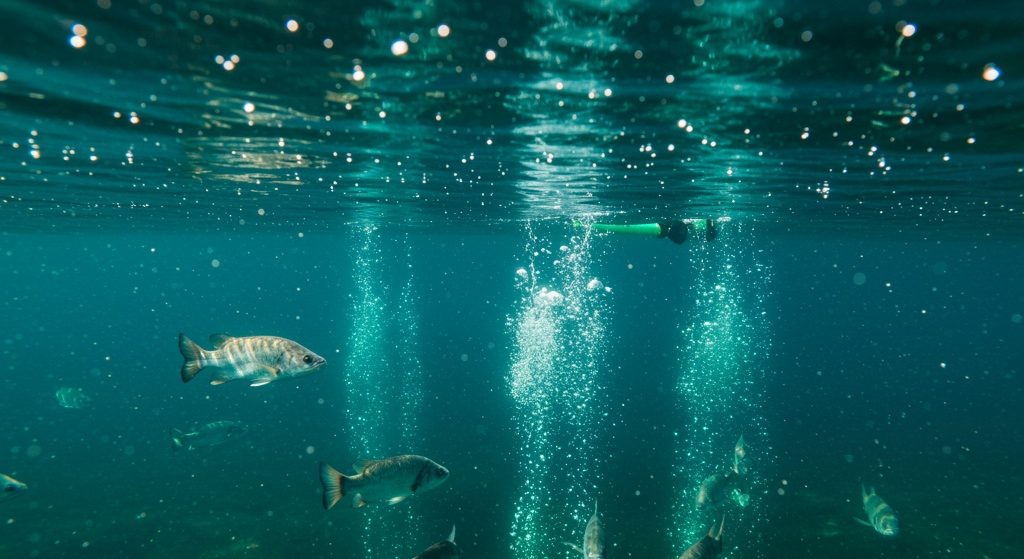When Oxygen Drops, So Do Livestock: The Critical Role of Aeration in Aquaculture Biosecurity

Introduction
In aquaculture, few environmental factors are as essential, or as sensitive, as dissolved oxygen (DO). It plays a central role in the health, growth, and survival of aquatic livestock. As the Australian aquaculture industry continues to scale up to meet national production targets, the ability to maintain stable DO levels has become more important than ever, particularly for farms operating in regional or remote areas.
Industry guidance highlights that oxygen is introduced into water through two key processes: photosynthesis by aquatic plants such as phytoplankton, and diffusion at the air–water interface. Natural aeration may be influenced by wind, surface agitation and light, but these conditions are far from consistent. The most reliable way to safeguard livestock health and maintain biosecurity is through artificial aeration. This is where ESAM’s side channel blowers and around-the-clock support provide critical value to aquaculture operators.
Why Dissolved Oxygen Matters
All aquatic life forms, from fish and crustaceans to plankton and beneficial bacteria, rely on dissolved oxygen for survival. In managed systems, oxygen is constantly being depleted through respiration and the breakdown of organic matter. A shift in temperature, feeding patterns, weather, or biological activity can quickly cause DO levels to fall below safe thresholds.
Diurnal fluctuations in DO are common. Concentrations typically reach their lowest point just before sunrise when photosynthesis has paused overnight and oxygen consumption has continued. Without continuous aeration, farms can wake to fish stress, poor feed conversion, or even mortality events.
Species like silver perch can tolerate short-term exposure to DO levels as low as 2 mg/L, but prolonged exposure to anything under 3 mg/L can severely impact growth rates and stress tolerance. In high-density systems, even small changes in oxygen availability can result in significant losses.
Signs of Low Oxygen
There are often early behavioural indicators that DO levels are becoming dangerously low. These include:
- Fish gasping at the surface
- Lethargy or lack of appetite
- Clustering near inlets or aerators
- Larger fish dying before smaller ones
These signs point to rising physiological stress, reduced performance, and increased vulnerability to disease. At this stage, response time is critical.
What Causes DO Crashes
There are many interacting factors that can lead to sudden drops in oxygen availability. Common causes include:
- Dense blooms of phytoplankton or zooplankton that respire heavily overnight
- Sudden die-off of algal blooms (often referred to as a “bloom crash”)
- High stocking densities or aggressive feeding regimes
- Excess turbidity limiting light penetration and photosynthesis
- Extended periods of still, overcast weather
These challenges often occur together, particularly in summer or during system transitions. Without a robust aeration plan, DO can quickly drop to harmful levels.
Preventing and Managing Low DO
To manage these risks, operators are advised to follow a layered strategy that includes:
- Regular monitoring – Use DO meters to track daily fluctuations and identify high-risk times.
- Continuous aeration – Keep aeration systems running overnight, not just during daylight hours.
- Emergency backup – Add additional blowers or backup aerators to activate during critical events.
- Adjust feeding – Temporarily pause or reduce feeding when oxygen levels are under pressure.
- Promote circulation – Use surface sprays or circulation tools to enhance air exchange.
- Remove waste – Dead organic material increases biological oxygen demand and should be removed promptly.
Being proactive in managing DO reduces both operational and biosecurity risks.
How ESAM Supports DO Stability
ESAM’s side channel blowers play an important role in ensuring oxygen levels remain stable and responsive to demand.
Designed for Continuous Operation
Our blowers are built in Italy to ISO 9001 standards and are individually tested both overseas and locally. They are engineered to run reliably, around the clock, under demanding environmental conditions.
Low Maintenance, Built for the Field
With a robust, low-maintenance design, ESAM blowers are ideal for regional locations where quick access to service or replacement parts can be challenging.
Protecting Livestock Health and Biosecurity
Consistent DO levels are key to reducing fish stress, supporting feed conversion, and preventing disease. By keeping oxygen availability steady, ESAM blowers contribute directly to improved biosecurity outcomes and long-term system resilience.
Conclusion
As Australian aquaculture continues to scale, the importance of dissolved oxygen cannot be overstated. It is central to both productivity and livestock health. DO issues are not just water quality problems—they are biosecurity concerns that can affect the entire operation.
Aeration is one of the few tools that can offer immediate protection and long-term performance. Investing in a reliable aeration system is not only a matter of efficiency but also a safeguard for the health of your stock and the sustainability of your business.
Whether you farm barramundi, silver perch or redclaw, consistent aeration should be a non-negotiable part of your management strategy.
Explore how ESAM can support your DO strategy today.
Call 03 9484 5719 or visit www.esam.com.au
Reference:
“Monitoring Dissolved Oxygen.” Department of Primary Industries – Aquaculture Water Quality Publications. Accessed August 2025. https://www.dpi.nsw.gov.au/dpi/fishing/aquaculture/resources/publications/water-quality/monitoring-disolved-oxygen